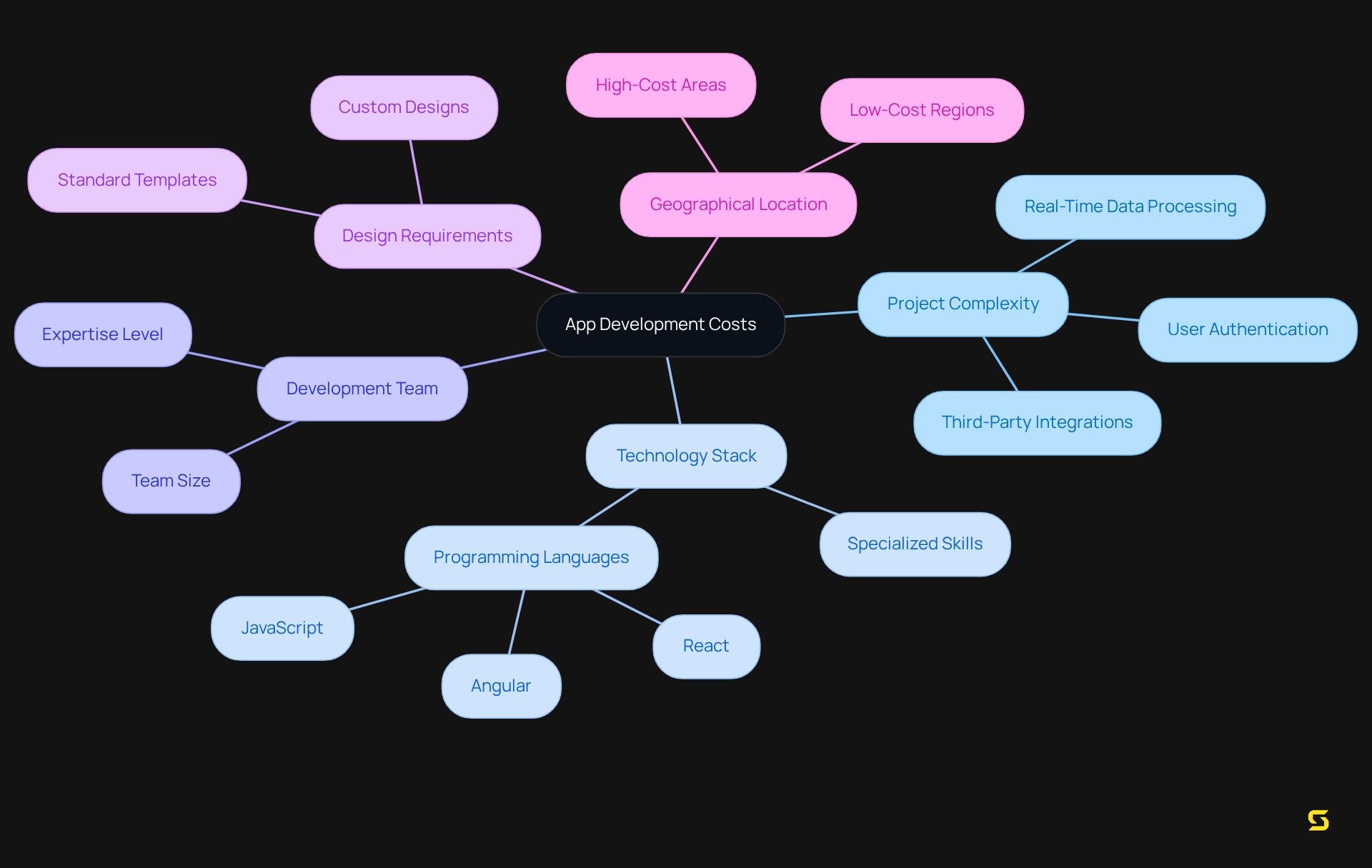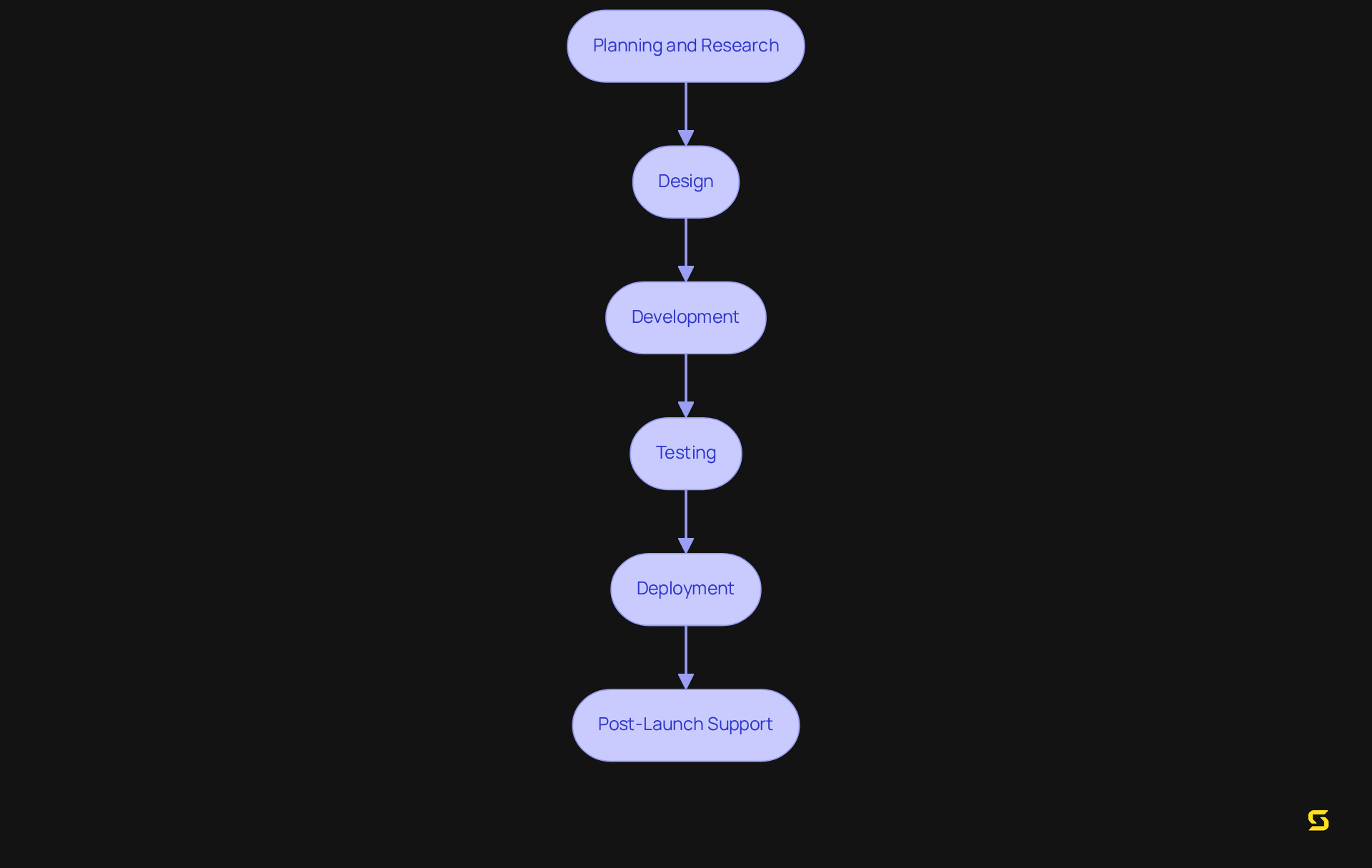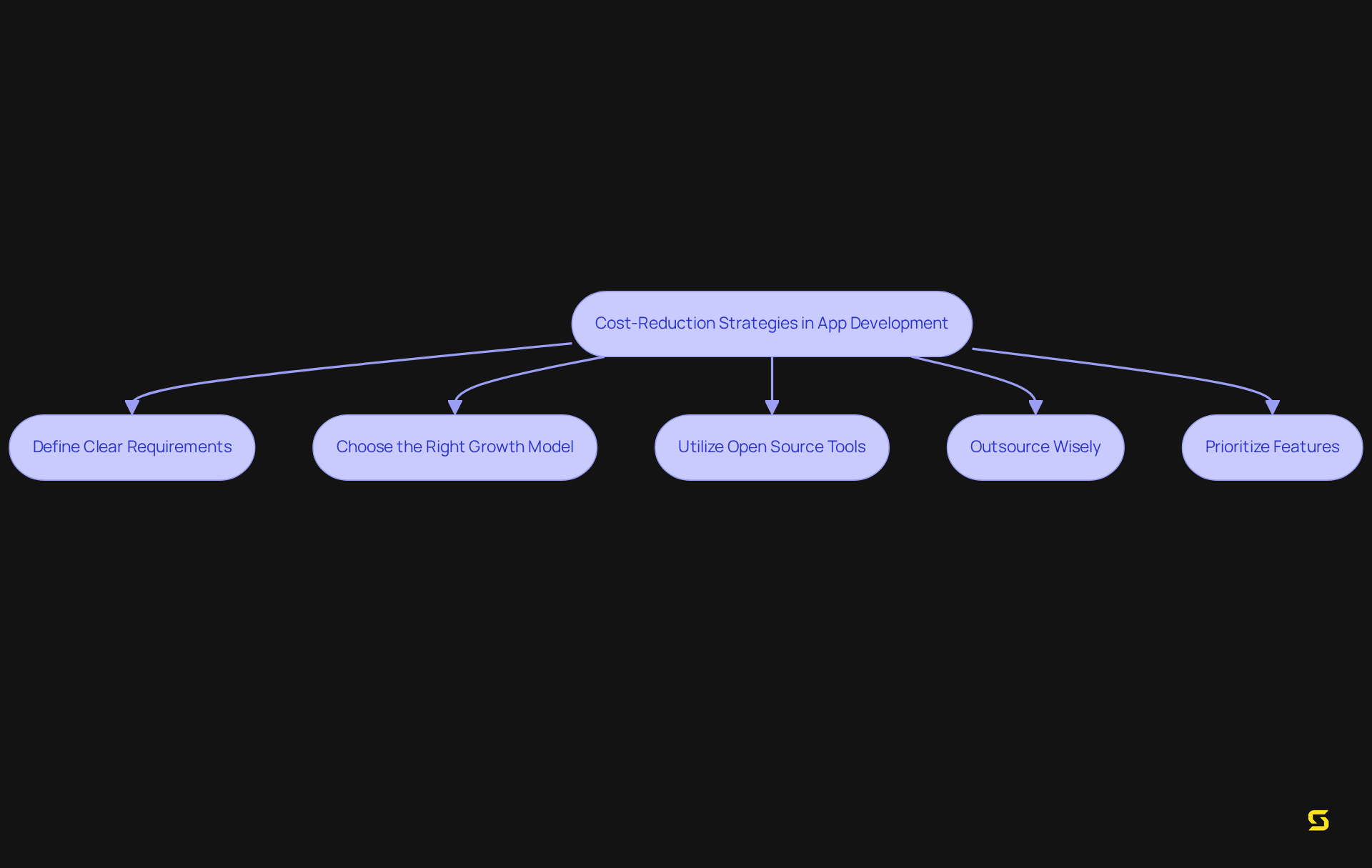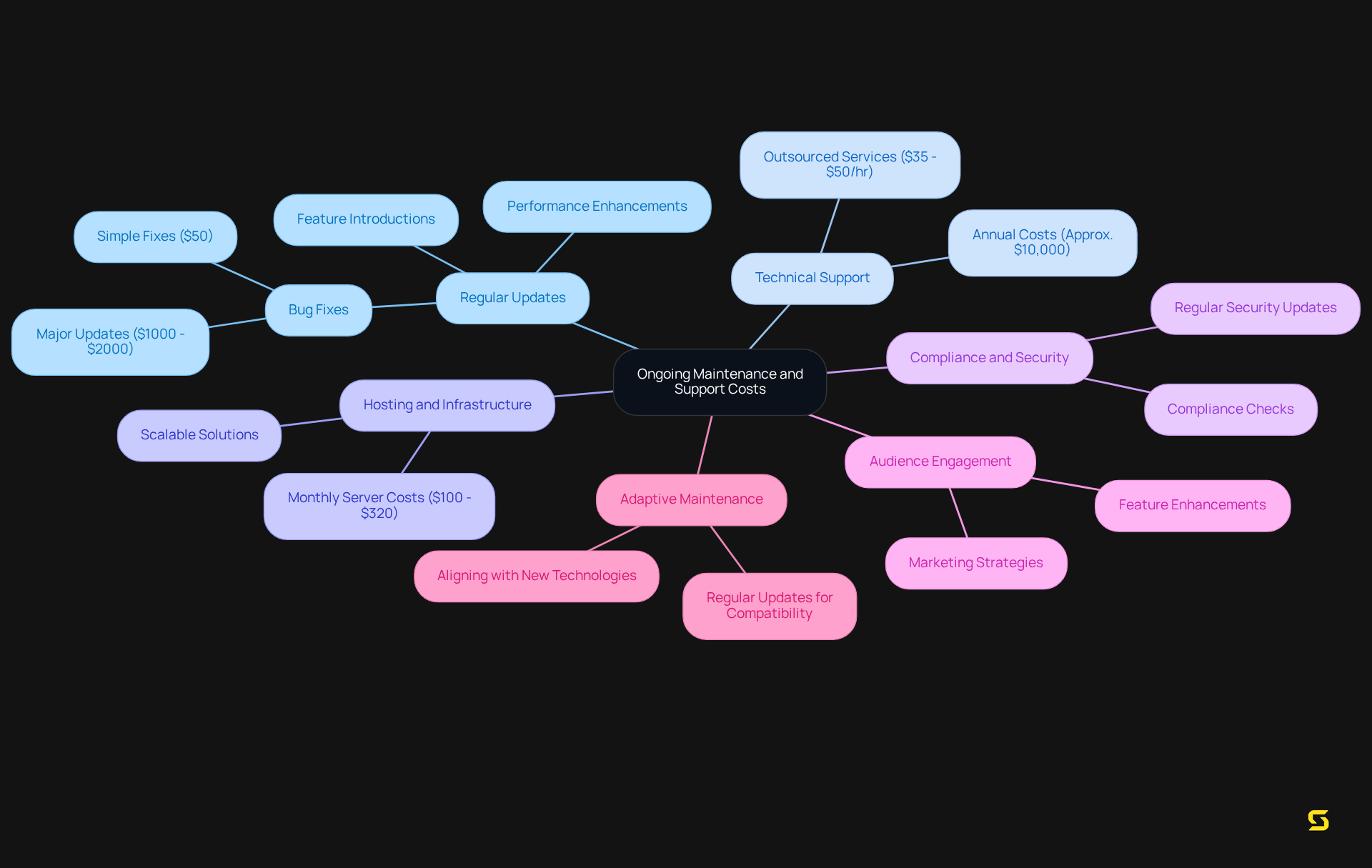Overview
Understanding the costs associated with app development requires a thorough examination of critical factors:
- Project complexity
- Technology stack
- Team expertise
- Design requirements
- Geographical location
These elements significantly influence expenses. By breaking down the development process into stages and implementing effective cost-reduction strategies, stakeholders can proactively prepare for and manage their app development budgets. This strategic approach not only enhances financial planning but also ensures that projects remain aligned with business objectives.
Introduction
Navigating the financial landscape of app development presents a significant challenge for many businesses. With numerous factors influencing costs—from project complexity to geographical location—strategic planning and careful consideration are essential. This article explores the critical elements that determine app development company costs, providing insights on effectively managing expenses while ensuring a high-quality product.
What strategies can stakeholders implement to balance budget constraints with the imperative for innovation and user engagement?
Understand Key Factors Influencing App Development Costs
To effectively gauge the costs associated with app development, it is essential to consider several key factors:
-
Project Complexity: The intricacy of the application directly correlates with expenses. Features such as user authentication, real-time data processing, and third-party integrations can significantly extend development time and costs.
-
Technology Stack: The choice of programming languages and frameworks, including JavaScript, React, and Angular, can impact expenses. Certain technologies may necessitate specialized skills, leading to increased labor costs.
-
Development Team: The size and expertise of the development team are crucial. While a team with extensive experience may command higher fees, they often deliver superior quality and efficiency.
-
Design Requirements: UI/UX design is critical for user engagement. Custom designs typically incur higher costs compared to standard templates.
-
Geographical Location: Development costs vary by region. Businesses located in high-cost areas often charge more than those in regions with lower living expenses.
By comprehending these elements, you can more accurately assess the potential expenses involved in the app development company cost for your project.

Break Down the App Development Process into Stages
The app development process is a multifaceted journey that can be divided into several key stages, each with its own app development company cost implications.
-
Planning and Research: This initial phase is critical as it involves defining the app's purpose, target audience, and features. Costs incurred during this stage include market research and initial consultations with development teams, laying the groundwork for a successful project.
-
Design: In this stage, UI/UX designers craft wireframes and prototypes, a process where the intricacy of the design significantly influences expenses. Custom designs typically command higher costs compared to standard templates, reflecting the value of tailored user experiences.
-
Development: Here, the actual coding takes place, and costs can vary widely based on the chosen technology stack and the number of features being developed. This phase often represents the most significant portion of the overall budget, underscoring its importance in the app's lifecycle.
-
Testing: Quality assurance is paramount to ensure the app functions correctly across various devices and platforms. Testing expenses can differ based on the number of devices and platforms requiring assessment, emphasizing the need for thorough evaluation.
-
Deployment: Launching the app incurs additional costs, including app store fees and marketing expenditures. This stage is crucial, as it not only signifies the app's entry into the market but also impacts its initial reception.
-
Post-Launch Support: Following deployment, ongoing support and updates are essential to maintain the app's performance and security. This can represent a continuous expense that should be incorporated into the budget, ensuring longevity and user satisfaction.
By understanding these stages, stakeholders can better prepare for the financial implications of app development company cost, ultimately leading to more informed decision-making and successful project outcomes.

Implement Cost-Reduction Strategies During Development
To effectively manage and reduce costs during the app development process, consider implementing the following strategies:
-
Define Clear Requirements: Establishing a well-defined project scope is crucial. Well-defined requirements minimize alterations during the process, which can contribute to a lower app development company cost. As highlighted by industry insights, "42% of startups fail due to the absence of demand for their product in the market," underscoring the importance of a solid foundation in project requirements. A structured approach to defining these requirements can significantly enhance project efficiency.
-
Choose the Right Growth Model: Opt for agile methodology when suitable. This model provides flexibility and can lower expenses, including the app development company cost, by prioritizing essential features first, allowing teams to adapt to changes without incurring substantial costs. For instance, companies that have successfully implemented agile methodologies report improved responsiveness to market demands and reduced time-to-market.
-
Utilize Open Source Tools: Leveraging open-source libraries and frameworks can lead to substantial savings in both time and money. By utilizing available resources, you can bypass the app development company cost associated with creating everything from scratch, enabling a more efficient development process. This method not only reduces costs but also accelerates the development timeline.
-
Outsource Wisely: If specialized knowledge is necessary, consider outsourcing to regions with lower labor costs. This approach grants access to skilled professionals while maintaining quality standards, ultimately reducing the app development company cost and overall project expenses. Various case studies demonstrate that outsourcing can lead to significant cost reductions without compromising on quality.
-
Prioritize Features: Focus on developing a Minimum Viable Product (MVP) initially. This strategy facilitates a quicker launch and the opportunity to gather feedback from users before committing to additional features, ensuring that resources are allocated efficiently. By prioritizing features, you can validate your app's concept and make informed decisions regarding future enhancements.
By applying these strategies, you can effectively manage the app development company cost while delivering a high-quality product that meets client needs.

Consider Ongoing Maintenance and Support Costs
After launching your app, ongoing maintenance and support are critical to ensure its success. Consider the following key factors:
-
Regular Updates: Apps necessitate regular updates to address bugs, enhance performance, and introduce new features. These updates are vital for boosting revenue and retaining customers. Allocate funds for these updates as part of your long-term financial strategy to account for app development company cost.
-
Technical Support: Providing user assistance can incur expenses, especially if a dedicated team is needed to handle inquiries and issues. Outsourced app maintenance services typically range from $35 to $50 per hour, which can accumulate significantly. On average, the app development company cost for technical support can reach approximately $10,000 annually, depending on the scale of your operations.
-
Hosting and Infrastructure: Hosting expenses can vary based on your app's architecture. Monthly server maintenance can range from $100 to $320, so be sure to incorporate these costs into your app development company cost as your user base grows.
-
Compliance and Security: Maintaining compliance with regulations and safeguarding against threats is an ongoing expense that must not be overlooked. Regular security updates and compliance checks are essential to protect personal data and uphold user trust.
-
Audience Engagement: Investing in strategies for audience engagement, such as marketing and feature enhancements, is crucial for retaining users and driving growth. However, these initiatives also require budget allocation. For an app valued at $100,000, the app development company cost for annual maintenance expenses is estimated to be between $15,000 and $25,000, which should be factored into your financial planning.
-
Adaptive Maintenance: Keeping applications aligned with new technologies and trends is essential. This ongoing maintenance ensures that your app remains relevant and functional, enhancing both performance and user experience.
By considering these ongoing costs, you can formulate a more accurate financial plan that supports the long-term success of your app.

Conclusion
Understanding the costs associated with app development is crucial for any business aiming to create a successful application. This article underscores the multifaceted nature of app development costs, highlighting that various factors—such as project complexity, technology stack, team expertise, design requirements, and geographical location—significantly influence overall expenses. By gaining insight into these elements, stakeholders can make informed decisions that align with their budget and project goals.
The breakdown of the app development process into distinct stages—from planning and design to testing and deployment—reveals that each stage carries its own cost implications. This underscores the importance of thorough planning and execution. Furthermore, effective cost-reduction strategies are outlined, including the necessity of:
- Defining clear project requirements
- Utilizing open-source tools
- Prioritizing essential features to manage expenses while maintaining quality
Ultimately, the significance of ongoing maintenance and support cannot be overstated. Regular updates, technical support, and compliance measures are vital for the app's longevity and user satisfaction. By understanding and planning for these ongoing costs, businesses can ensure their app remains relevant and functional in a competitive market. Embracing these insights not only aids in budgeting but also sets the foundation for a successful app development journey.
Frequently Asked Questions
What are the main factors that influence app development costs?
The main factors influencing app development costs include project complexity, technology stack, development team expertise, design requirements, and geographical location.
How does project complexity affect app development costs?
Project complexity affects costs as intricate applications with features like user authentication, real-time data processing, and third-party integrations require more development time and resources, leading to higher expenses.
What role does the technology stack play in determining app development costs?
The technology stack, which includes programming languages and frameworks like JavaScript, React, and Angular, can impact costs. Some technologies may require specialized skills, increasing labor costs.
How does the development team size and expertise impact costs?
The size and expertise of the development team are crucial; a more experienced team may charge higher fees but can provide better quality and efficiency in the development process.
Why are design requirements important in app development costs?
Design requirements are important because custom UI/UX designs typically incur higher costs than standard templates, affecting the overall budget for the project.
How does geographical location influence app development costs?
Geographical location influences costs as businesses in high-cost areas often charge more for development services compared to those in regions with lower living expenses.





